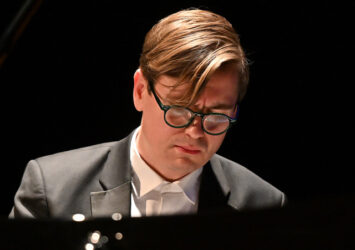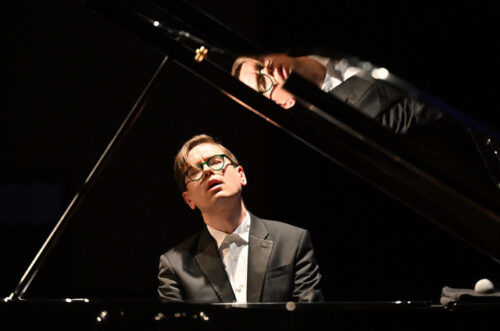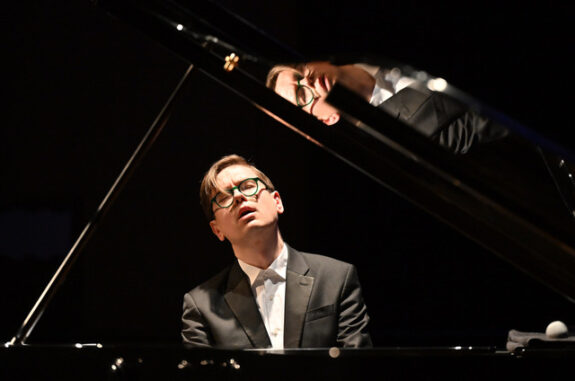 United Kingdom Glass, Finnis: Vikingur Ólafsson (piano). Purcell Room, 24.9.2022. (MB)
United Kingdom Glass, Finnis: Vikingur Ólafsson (piano). Purcell Room, 24.9.2022. (MB)

Glass – Opening from Glassworks; Etudes Nos. 9,2,3,5,6 and 20
Edmund Finnis – Mirror Images
Music is sometimes associated only with a memory, and so it is with Philip Glass’s Etudes. Over the years I have thought there was something Shakespearean about the composer’s performances of them – of Glass as a kind of King Lear figure playing at the piano. If this suggests a vulnerability, then forget it. He often plays these pieces faster and with more energy than anyone else. The Lear analogy has more to do with Glass being a force of nature. This seemed to be the case when I heard him play them in Paris.
This doesn’t have much to do with Vikingur Ólafsson’s Purcell Room recital – although this, rather like Pierre-Laurent Aimard’s journey through Stockhausen’s Klavierstücke a few years ago, also left something of an impression afterwards. Some twentieth-century piano music is, in my view, every bit as great as that written in the nineteenth century – Shostakovich, Bartók, Stockhausen, Boulez, Cage. And Philip Glass’s Etudes.
These pieces are unlike those by Chopin in that the Glass ones are more endlessly open to variables in interpretation, not least in the speed in which pianists take them. This is especially the case with Etude No.20, which is highly ambivalent in meaning, a work that almost stands outside its nineteen earlier ones – so much so that even the composer struggles to understand both its place in the sequence and its meaning. Etude No.6 is another – Ólafsson mentioned during his opening remarks (he is a witty and sage-like speaker, by the way, with a warmth that seems at odds with his icy looks) that Glass thought he didn’t bring enough depth or pathos to it. It is certainly one of the darkest of the cycle although when Glass asks his pianist to look for answers in this work, he suddenly cuts off the piece with brutal excision.
One could argue that the small selection that Ólafsson chose to play were weighted towards the first book of Etudes – that is, the first ten of them, all written in 1994. These tend to be the more technically based, the ones which don’t always look too far beyond the black and white keys of the instrument Glass wrote for. In fact, this didn’t feel true of No.6 at all. Bearing in mind Ólafsson’s thoughts on what Glass said, the performance sounded very bleak, octaves were heavy (but not heavy-handed). It had a weight which almost suggested Brahms. With Ólafsson you don’t really invest in clock time; it’s more a case of allowing yourself to forget about minutes and seconds altogether. No.6 felt neither long nor short – it just felt right.
No.9 was, I think more elastic than on his DG recording – a combination of the meditation and mellowness with that electricity that fired up a speedier tempo. No.2 swept in like crashing waves, the equilibrium swinging the pendulum towards dreamy repetition. Ólafsson built this piece up until what we had looked like the veneer of a book with coarse-trimmed leaves, just slightly rough on the surface. He played No.3 with an expressive urgency, No.5 with a wide tonal range and deftness of colour as the left and right hands travelled in separate directions.

Common to his playing of all of the Etudes, was gentle, slow-rising pedalling that is so subtle. The keyboard had remarkable clarity and there was no ebbing of the sound, no note that had an echo after it.
Edmund Finnis’s Mirror Images, premiered at this performance, was the longest work on the program and sat bang in the middle of it. It is not a piece that sounded out of place beside the Glass works and its nine sections, split between a quarter-of-an-hour running time, rarely collided with each other. One of the reasons Glass’s music is relatively easy to focus on is because there is a focal point a listener can concentrate on or at least gravitate towards. With Finnis’s work this wasn’t the case and one’s attention often wandered and strayed. Even though Mirror Images does have shifting tempos and it does have patterns, they aren’t as well assimilated into the work’s long (or so it felt) running time. Ólafsson clearly liked the piece – his concentration was impressively self-assured; he was able to sustain the long lines of musical sameness that thread through the work and he brought enough tonal colour to it to make the shimmering reflections of the score have movement rather than just remain static. I am afraid I didn’t quite feel the same about it.
The two works that bookended the recital – Opening, from Glassworks, and Etude No.20 – are both in their own ways enigmatic pieces. This was, I think, the slowest performance of Opening I have come across from Ólafsson. If my watch was correct it took him almost ten-minutes to play it which is longer than on his DG recording, and considerably longer than a performance he is known to have given where he took just five minutes. It is reasonably rare for a piece to work with this kind of tempo flexibility – try this with the Zoltán Kocsis transcription of Wagner’s Prelude to Tristan und Isolde and you would be in real trouble. It was, however, a superb performance. Wonderful left- and right-hand interlacing, which gave the music a beautifully rolling and cresting feeling. I think the more deliberate tempo made the suspension of chords just slightly more riveting – the tension more elastic and bending. The score is almost completely lacking in dynamic markings and yet Ólafsson made it sound evocative and magical. This can get lost in faster performances where interpretations take on a different meaning; here Ólafsson set a trend that would be closer to the Etudes.
And that last Etude, the 20th, if it never solved any of the mysteries behind its composition, then he was never indifferent towards giving a charismatic performance of it. Technically, as with everything in this recital, his playing was faultless. So exquisite was the sound from the piano, too. Glass perhaps needs to sound this crystalline and pure and it certainly did here.
Vikingur Ólafsson mentioned during his little intros that he hadn’t played the Glass works for several years. Time makes a difference – and he has grown into them, and I think he has re-worked his thinking on some of the Etudes. But this is music that is largely free of the composer’s intervention – Glass rarely tells the pianist what he should do. It allows very much for original performance and the discography for these works is a very unique one. This was the first of two recitals that Ólafsson was giving the same evening; quite possibly the second one would have been different in certain respects.
An enjoyable recital.
Marc Bridle
